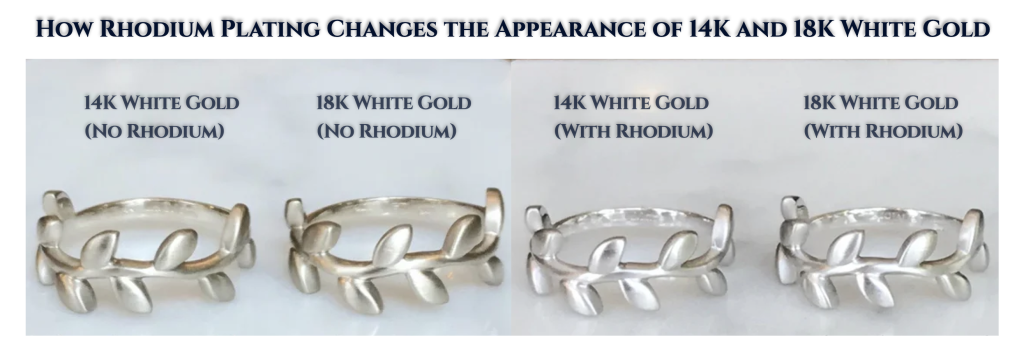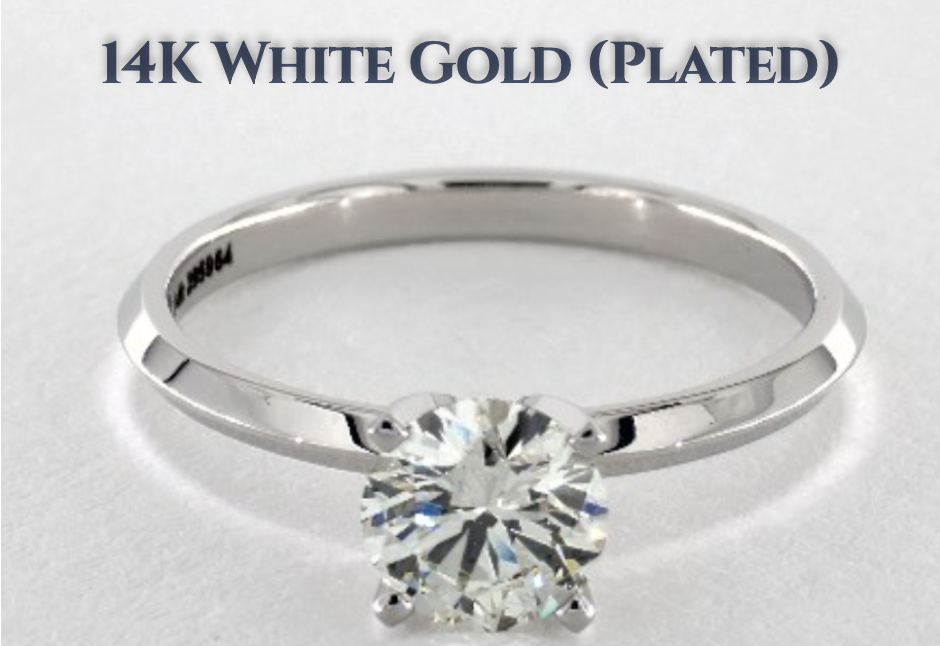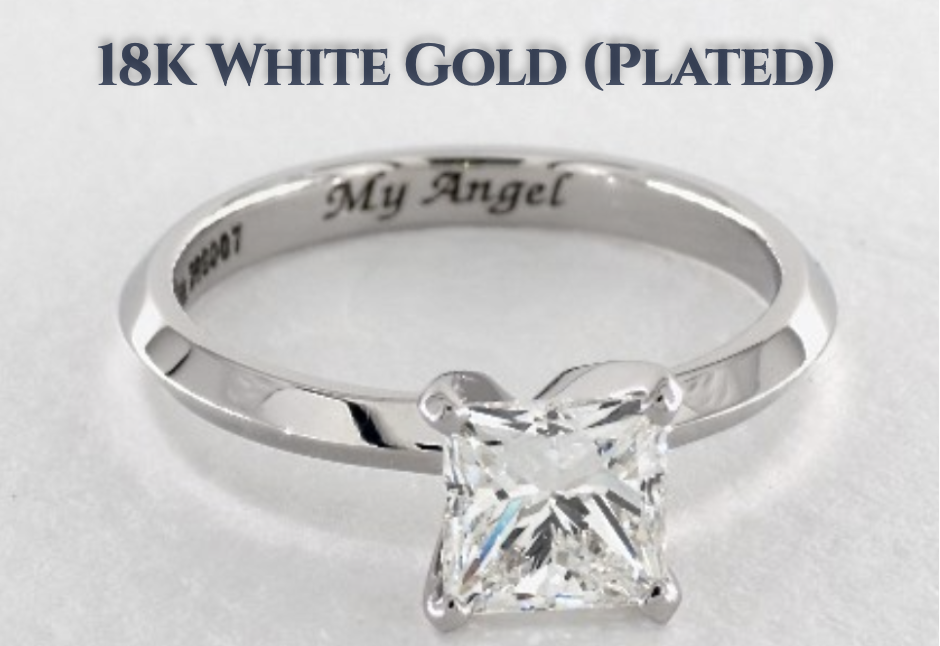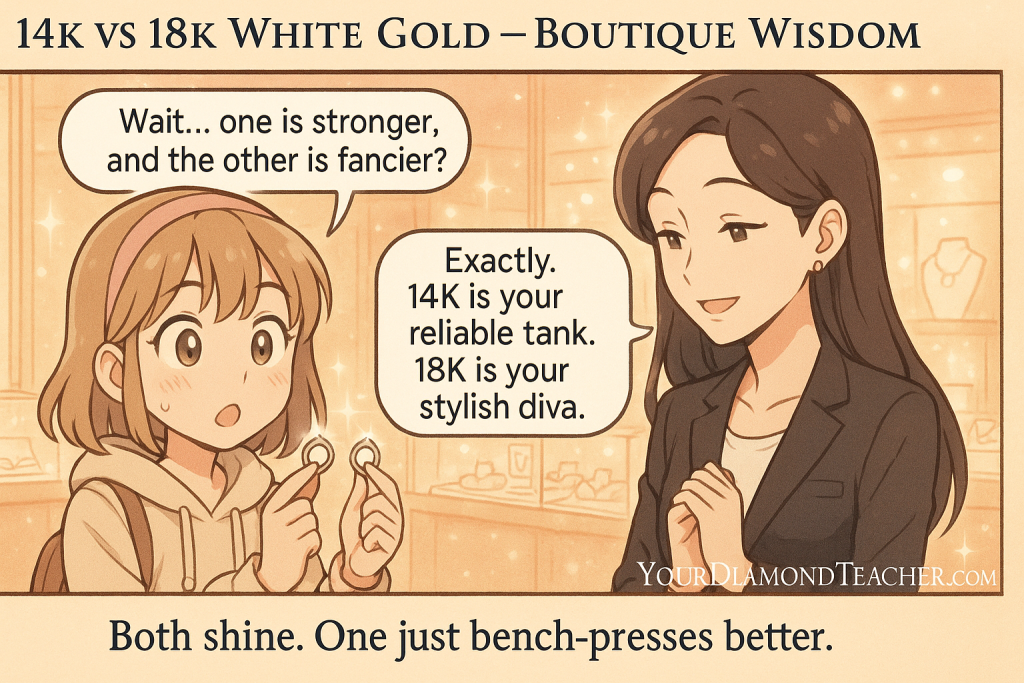White gold might look the same at first glance, but when you’re deciding between 14K and 18K, there are some important differences you need to know. Before we dive in, a quick clarification: the “K” stands for karat, the measure of gold purity, not to be confused with carat, which measures the weight of gemstones like diamonds.
Whether you’re shopping for an engagement ring, wedding band or a timeless piece of jewelry, understanding how these two karat levels compare can help you choose the one that fits your lifestyle, budget and personal style best. As of 2025, white gold remains the most popular choice for engagement rings in the U.S., a position it’s held since the early 2000s. Nearly half of all couples choose white gold, followed by yellow gold, rose gold and platinum. Wedding bands follow a similar trend.
Here’s a quick side-by-side of plated 14K vs 18K white gold chains. These are plated chains, so you’re seeing what most white gold jewelry looks like right out of the box:
As you’ll notice, once plated with rhodium, both appear nearly identical. The real differences lie beneath the surface.
In this guide, you’ll get a complete breakdown of how 14K and 18K white gold stack up: from color and durability to long-term value and care.
Quick Comparison: 14K vs 18K White Gold
If you’re in a hurry, this quick comparison table breaks down the key differences between 14K and 18K white gold. You’ll see how they differ in purity, durability, color, price and all the essentials to help you make a smart decision fast:
| Feature | 14K White Gold | 18K White Gold |
|---|---|---|
| Gold Content | 58.3% pure gold (14 parts gold, 10 parts alloy) | 75% pure gold (18 parts gold, 6 parts alloy) |
| Color | Cooler tone, slightly less bright due to more alloys | Warmer white hue with a touch of natural gold warmth |
| Durability | Stronger and more scratch-resistant, ideal for daily wear | Softer and more prone to dents or scratches over time |
| Price | More affordable and budget-friendly (see 14K price) | More expensive due to higher gold purity (see 18K price) |
| Allergy Risk | Slightly higher (may contain more nickel or alloy metals) | Lower risk for sensitive skin |
| Maintenance | Rhodium plating may last longer due to harder surface | May need more frequent rhodium re-plating |
| Best For | Active lifestyles, everyday rings, couples on a budget | Luxury pieces, heirlooms, soft white luster preference |
As you can see, both 14K and 18K white gold have their own unique strengths. The right choice really depends on your priorities. Whether you’re after durability for daily wear or a higher gold content for a more luxurious feel. Let’s take a closer look at what white gold is and how these karat levels actually differ in composition and appearance.
What Is White Gold and How Is It Made?
White gold isn’t found in nature, it’s a man-made metal created by mixing pure yellow gold with white-colored alloys such as palladium, nickel or silver. These alloy metals help to lighten the naturally yellow tone of gold and also improve its strength and durability, making white gold more resistant to bending than pure gold.
To achieve the bright, silvery appearance people expect from white gold, it’s almost always plated with rhodium, which is a rare, naturally white metal from the platinum family. This outer layer not only enhances shine but also adds scratch resistance and provides a hypoallergenic barrier for those sensitive to certain alloys like nickel.
Above, you can see a side-by-side comparison of a plated and an unplated 14K white gold chain. I chose chains for this visual because the difference is easier to see than it would be on a small ring. The plated chain is shown on top: it has a brighter, whiter and shinier finish that reflects light clearly and matches the appearance most people associate with white gold. In contrast, the unplated chain on the bottom has a dull gray tone, caused by the natural color of the underlying gold alloy. It lacks the sharp brilliance of rhodium-plated gold, which is why most white gold jewelry sold today is plated.
Most people don’t realize rhodium wears off and replating every 1-2 years can easily cost $50-$100 per session at a local jeweler. Over time, that adds up to significant maintenance costs. All of which James Allen customers can avoid thanks to James Allen’s lifetime warranty with free rhodium replating for life.
James Allen’s free lifetime rhodium replating is genuinely one of the most underrated perks in the engagement ring world. For anyone choosing white gold, it’s a practical benefit that adds long-term value and peace of mind. After all, white gold is the only ring metal that actually requires replating to maintain its bright, platinum-like look. Explore James Allen’s full white gold ring collection, every ring includes free lifetime replating.
Without rhodium plating, 14K white gold appears pale gray with a subtle yellow tint, while 18K looks even warmer, closer to champagne or creamy off-white.
When you think about it, it’s actually surprising that a metal requiring replating every couple of years has become the most popular choice for engagement rings! But the reason is simple: white gold offers the luxurious, bright look of platinum at a much more affordable price. And for most people that visual payoff outweighs the upkeep.
Its rise in popularity wasn’t instant, though. White gold was originally developed in the early 20th century as a substitute for platinum, which was not only rare and expensive but also restricted for military use during wartime. Still, it took several decades for white gold to catch on. It wasn’t until the 1980s that it truly began gaining traction, particularly in the U.S., as design trends shifted and modern brides embraced the sleek, icy aesthetic of white gold settings. Its platinum-like appearance combined with a significantly lower cost made it a natural favorite.
Today, white gold is the most popular metal for engagement rings in the U.S. and many Western countries, and is also widely used in wedding bands, earrings and other fine jewelry.
14K vs 18K White Gold: Main Differences
While both 14K and 18K white gold can look nearly identical at first glance, especially when rhodium-plated, the differences under the surface are significant. From purity and color tone to durability and price, here’s how the two compare across all the factors that matter most.
Color and Shine Differences
The actual color of 14K and 18K white gold before plating is not the same. The comparison below shows how rhodium plating transforms the color of both 14K and 18K white gold.

- Unplated 14K white gold has more alloy metals, which give it a slightly cooler, gray-white tone under the rhodium.
- Unplated 18K white gold contains more pure gold, which adds a warmer, creamier tint to the unplated metal.
Once plated with rhodium, both 14K and 18K white gold appear nearly identical at first glance: bright, reflective and cool-toned. In fact, most people will receive their white gold jewelry already rhodium-plated, as this is the industry standard in modern fine jewelry.
The rings below show how similar 14K and 18K white gold appear once they’ve both been rhodium-plated.


However, as the plating gradually wears off over time, 18K white gold may begin to show a slightly warmer undertone sooner than 14K, due to its higher gold content. The difference is subtle but can matter to buyers who are especially focused on maintaining the whitest possible appearance over the long term.
Durability and Scratch Resistance
- 14K white gold is stronger and more scratch-resistant, making it a better choice for people with active lifestyles or those who wear their rings daily.
- 18K white gold with more gold and fewer hardening alloys, is softer and more prone to dings or bending, especially in delicate settings or thin bands.
For daily wear, especially in engagement and wedding rings, 14K is typically the smarter choice thanks to its greater strength and resistance to scratches.
Long-Term Maintenance and Replating
Because both 14K and 18K white gold rely on rhodium plating to maintain their white finish, they’ll both eventually need replating, typically every 1 to 3 years depending on wear.
- 14K white gold tends to hold its plating longer, thanks to its harder surface
- 18K white gold may show warm undertones sooner, meaning more frequent replating may be needed to maintain that crisp white look
For most people who wear their ring daily, rhodium replating is typically needed every 18 to 24 months. Daily wear, hand washing, cleaning and gym use gradually break down the plating. If you’re very active or frequently expose your ring to water and cleaning agents, annual replating might be necessary. For occasional wearers, the finish can last up to three years or more.
Here’s what that process actually looks like:
The video below shows a 14K white gold ring being dipped into a rhodium solution, restoring its bright white surface after the original layer wore off.
By the way, if you’d rather avoid replating altogether, platinum can be a great alternative. It has a naturally bright white color that doesn’t fade, never needs plating and is highly hypoallergenic, meaning it is safe for everyone.
It’s heavier, more durable over the long run, but also more expensive upfront. Platinum develops a soft patina over time, but a quick professional polish will restore its original shine.
Here is a quick overview of how platinum compares to 14K and 18K white gold:
| Feature | 14K White Gold | 18K White Gold | Platinum |
|---|---|---|---|
| Gold/Platinum Content | 58.3% gold + alloys | 75% gold + alloys | ~95% platinum |
| Color | Cool white (when plated), cooler base metal | Cool white (when plated), warmer base metal | Natural bright white, subtle gray undertone |
| Durability | Strongest, best scratch resistance | Softer, more prone to dings/scratches | Very durable, develops a soft patina but doesn’t wear away |
| Maintenance | Replating every 1-3 years | Replating every 1-2 years | No plating needed, occasional polish |
| Allergy Risk | Possible (more alloys, often nickel) | Lower (less nickel, more gold) | Hypoallergenic |
| Price | $ (lowest) | $$ (mid-high) | $$$ (highest, can be double or more) |
| Weight/Feel | Lightest | Medium | Heaviest (noticeable “luxury” feel) |
| Resale Value | Scrap value only, typically low | Scrap value only, typically low | Highest resale value for a precious metal |
| Best For | Active daily wear, budget-conscious, low maintenance | Luxury, tradition, sensitive skin, prestige | Low-maintenance, luxury, heirloom, hypoallergenic needs |
For an in-depth look at platinum, including pros, cons and care tips, check out my comprehensive platinum guide.
Skin Sensitivity and Allergies
- 18K white gold is less likely to cause skin reactions, since it contains fewer alloy metals like nickel.
- 14K white gold has more alloy content, which slightly increases the chance of irritation in sensitive wearers, especially if the rhodium layer wears off.
If you’ve experienced reactions to jewelry in the past, 18K or nickel-free alloys are typically safer, though rhodium plating offers protection in either case.
Price and Value for Money
- 18K white gold contains 75% pure gold, making it more expensive, both for the metal itself and often for the finished piece.
- 14K white gold has 58.3% gold content, so it’s more affordable and offers better value in terms of durability per dollar.
That said, 18K white gold is often seen as more luxurious, especially in high-end designer or heritage jewelry.
Which One Is Better for Engagement Rings and Wedding Bands?
When it comes to rings that are worn every day like engagement rings and wedding bands the decision between 14K and 18K white gold becomes more than just a matter of appearance. While both metals can look virtually identical thanks to rhodium plating, their differences in durability, upkeep and overall practicality start to matter much more over time.
Engagement Rings: 14K vs 18K White Gold
For engagement rings, durability is often the deciding factor. These rings go through daily wear and tear, from washing hands to everyday bumps and exposure to household products. In this context, 14K white gold tends to be the better choice. It’s harder, more scratch-resistant and generally better equipped to protect delicate settings or center stones. It also holds its rhodium plating slightly longer than 18K, which means you may go a bit longer between re-plating appointments.
All of this makes 14K white gold a practical, no-nonsense option for anyone who wants beauty without too much maintenance. That’s why the vast majority of white gold engagement ring settings, namely around 75 to 80 percent, are made in 14K white gold.
That said, 18K white gold still has its place. Some buyers are drawn to the idea of a ring that contains more pure gold, especially when buying from luxury designers or when symbolism and tradition play a stronger role. While 18K is softer and will show signs of wear sooner, some people are comfortable with the trade-off, especially if the ring won’t be worn in situations where it might be easily damaged.
💡 Diamond Color Tip
When pairing diamonds with white gold, most people prefer to stay within the colorless to near-colorless range, usually D to H. Because white gold is a bright, reflective metal, it can make any warmth in lower-color diamonds (I or J and beyond) more noticeable. If you’re shopping for value, G or H often gives you the best balance: still bright and icy, but noticeably more affordable than the top-tier grades.
Wedding Bands: 14K vs 18K White Gold
For wedding bands, the choice can be more personal and nuanced. Many couples go with 14K white gold simply because it’s durable, cost-effective and matches their engagement ring. It’s especially popular among people who work with their hands or lead more active lifestyles. Around 70 to 75 percent of white gold wedding bands are made in 14K, making it the more common option by far. On the other hand, some choose 18K white gold for its richer feel and higher gold content. The subtle difference in weight and the warmer tone beneath the plating can be appealing, particularly when chosen to complement skin tone or an 18K engagement ring.
When it comes to men’s wedding bands, 14K white gold is often the preferred option simply because it holds up better to physical activity. For women, especially those who value the look and feel of higher gold content, 18K remains a popular and elegant choice.
In the end, 14K white gold is typically the better fit for those who prioritize durability, lower maintenance and long-term value. Meanwhile, 18K white gold is ideal for those who prefer a more luxurious option and don’t mind a bit of extra care to keep it looking its best. Both are beautiful metals, it just depends on how you plan to wear them.
Popular Ring Styles in 14K and 18K White Gold
While both 14K and 18K white gold can be crafted into virtually any style, some designs tend to suit one karat level better than the other. Either for practical reasons or because of the aesthetic and symbolic qualities each metal brings to the piece.
In 14K white gold, styles that emphasize daily durability are particularly common. Solitaire settings, pavé bands and halo rings are all popular because they hold up well in 14K’s harder metal composition. Prongs in 14K white gold tend to maintain their grip on center stones longer, which makes this karat level especially suitable for rings that will be worn every day without worry. You’ll also see 14K widely used in cathedral settings, hidden halos and more modern or minimalist designs where structure and longevity are key.
On the other hand, 18K white gold is often favored in luxury and designer settings, where gold purity carries symbolic weight and the slightly softer metal can be crafted into more fluid or organic forms. It’s frequently used in vintage-inspired rings, floral motifs and intricate filigree work where a subtle warmth in tone enhances the overall character of the ring. High-end brands often reserve 18K for their signature collections, giving buyers a sense of exclusivity and heritage.

If you’re still deciding on the right setting, check out my full engagement ring settings guide to explore every popular style, from timeless solitaires to vintage halos and hidden accents.
For wedding bands, 14K white gold is especially popular in classic domed and flat bands, particularly for men or anyone who wants a ring that will hold up to everyday wear. 18K white gold bands, while a bit softer, are often chosen for their smooth finish, slightly heavier feel and deeper connection to the idea of long-lasting value and sentiment.
In short, 14K white gold shines in practical, structured, everyday designs, while 18K white gold tends to be the metal of choice for elevated, symbolic and more ornate pieces. Both metals offer stunning results and it just depends on whether you prioritize strength or softness, everyday use or heirloom appeal.
Expert Tips for Choosing the Right Karat
Choosing between 14K and 18K white gold isn’t just about purity or price, it’s about how the ring fits into your life. Jewelers often ask buyers a few simple but telling questions: How often will you wear the ring? Do you work with your hands? Is skin sensitivity a concern? The answers usually point clearly toward one karat level or the other.
If your lifestyle is active or you rarely take off your ring, 14K white gold is the practical choice. Its higher alloy content makes it harder, more scratch-resistant and better at holding prongs. Which is perfect for engagement rings, wedding bands or stackable styles.
On the other hand, if you’re drawn to the idea of wearing a ring with more pure gold and don’t mind a little extra upkeep, 18K white gold may feel more meaningful. Some people simply prefer the idea of a ring that’s 75% real gold, especially for symbolic pieces like wedding bands or heirloom designs. If you’re not too rough on your jewelry and you love the idea of a slightly heavier, more precious-feeling ring, 18K can be a great fit.
For buyers with sensitive skin, 18K also tends to cause fewer allergic reactions, since it contains fewer alloy metals. That said, rhodium plating on both karat levels usually offers protection, but it’s still worth considering if you’ve had issues with jewelry in the past.
At the end of the day, 14K offers better resilience for everyday wear, while 18K delivers more purity and prestige. The best choice is the one that fits your daily life and what you value most.
Our Key Takeaway
After weighing durability, maintenance and purity, your choice between 14K and 18K white gold really comes down to what matters most in your day-to-day life. If practical resilience is your top priority, 14K white gold won’t disappoint. If meaningful purity and luxury take precedence, 18K makes a beautiful and symbolic statement.
James Allen is our most recommended engagement ring retailer and many of our readers have had great experiences with their service, support and customization options. They offer an impressive selection of 14K and 18K white gold ring settings, with a wide variety of styles ranging from timeless solitaires to detailed vintage-inspired designs. Whether you’re after something minimalist or ornate, their inventory is one of the most flexible and beginner-friendly in the industry. Read my full James Allen review, where I recently made a test purchase for a 14K white gold engagement ring to evaluate the experience firsthand.
We also highly recommend Blue Nile, especially for their premium in-house and designer ring settings, which feature elegant craftsmanship and often come in both 14K and 18K options. And if you’re focused on cut quality and want to pair your setting with a high-performance diamond, Whiteflash is a standout choice. Their designer collections and signature diamonds are second to none for buyers seeking precision and brilliance.
In the end, there’s no wrong answer, just the one that fits your story best. Whether you choose 14K for durability or 18K for sentiment, both will look stunning when paired with the right stone and setting. The key is knowing what matters most to you and picking a jeweler that helps bring that vision to life.